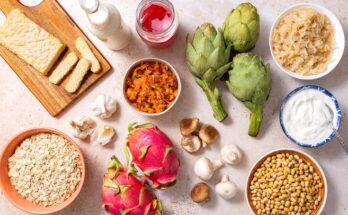Cashew Cream Recipe: Cashew cream is one of those magical recipes that can completely change the way you look at dairy-free cooking. It’s rich, silky, and versatile enough to use in both savory and sweet dishes.
Whether you’re vegan, lactose-intolerant, or simply trying to add more plant-based meals into your life, cashew cream is an absolute game-changer.
In this guide, we’ll go through everything you need to know—from the ingredients to step-by-step instructions, plus tips and variations to suit your taste.
What is Cashew Cream?
Cashew cream is a smooth, creamy sauce made by blending soaked cashews with water. The result is a dairy-free alternative that mimics the texture and richness of heavy cream, sour cream, or even cheese in some cases. Unlike some other nut-based creams, cashew cream has a very mild flavor, which makes it a perfect base for both savory and sweet dishes. You can use it in pasta sauces, soups, curries, dips, desserts, or even as a dairy-free creamer in coffee.
Think of it as the Swiss Army knife of vegan cooking—it can take on so many roles in the kitchen. If you’ve ever struggled with recipes that call for cream but don’t want the heaviness of dairy, cashew cream is your go-to solution.
Why Cashew Cream is a Great Dairy-Free Alternative
There are many reasons people turn to cashew cream instead of dairy cream. For some, it’s about health—cashews are packed with healthy fats, protein, and essential vitamins like magnesium, zinc, and vitamin K. For others, it’s about lifestyle—vegans and those with lactose intolerance often need reliable substitutes.
Unlike coconut cream, which has a strong flavor, cashew cream blends seamlessly into almost any recipe. It doesn’t overpower other ingredients but instead enhances them. On top of that, cashew cream is lower in saturated fat compared to heavy cream, making it a lighter option without sacrificing creaminess.
To put it simply: cashew cream gives you that indulgent, creamy texture without the heaviness of dairy.
Ingredients You’ll Need
Core Ingredients for Basic Cashew Cream
Making cashew cream couldn’t be simpler. You only need two basic ingredients:
- Raw Cashews – Always choose raw, unsalted cashews. Roasted or salted versions will alter the flavor.
- Water – Use fresh, filtered water for soaking and blending.
That’s it—two ingredients, and you’ve got yourself the foundation of cashew cream.
Optional Flavor Enhancers
While plain cashew cream is delicious, you can take it up a notch by adding:
- Salt – Just a pinch enhances flavor, especially for savory dishes.
- Lemon Juice – Adds brightness and a slight tang, perfect for sauces.
- Garlic – Blended in for a savory, cheesy-like cream.
- Vanilla Extract – A great option if you’re making a sweet cashew cream.
- Maple Syrup or Honey – For natural sweetness in desserts.
These add-ons allow you to customize cashew cream to suit any dish.
Substitutions for Different Diets
The beauty of cashew cream lies in its adaptability. If you want to make it nut-free, you can substitute sunflower seeds. For a keto-friendly version, you can reduce the water for a thicker cream that’s lower in carbs. Even those who need low-sodium options can skip the salt without sacrificing too much flavor.
Cashew cream isn’t just for vegans or those with allergies—it’s a recipe that can be tailored to nearly any diet.
Step-by-Step Guide to Making Cashew Cream
Now let’s dive into the actual process of making cashew cream. Don’t worry—it’s simple, but getting each step right makes all the difference in texture and taste.
Step 1 – Selecting Quality Cashews
The first step is choosing the right cashews. Always go for raw, unsalted cashews. Avoid roasted or salted ones, as they carry stronger flavors that don’t blend well into creamy bases. Also, check for freshness—stale cashews can give your cream an off taste. If you can, buy cashews from a store with high turnover to ensure they’re fresh.
Think of cashews as the star of the show. Just like how good coffee starts with good beans, good cashew cream starts with quality nuts.
Step 2 – Soaking Cashews Properly
Soaking cashews is one of the most important steps. This process softens them, making them easier to blend into a smooth, creamy consistency. You have two options:
- Overnight Soak – Place cashews in a bowl, cover with water, and let them sit for 6–8 hours or overnight.
- Quick Soak Method – If you’re in a rush, boil water and pour it over cashews, letting them soak for about 30 minutes.
Either method works, but the overnight soak usually gives a smoother cream. After soaking, drain and rinse the cashews to remove any residue.
Step 3 – Blending to Perfection
Once soaked, transfer your cashews to a blender. Add fresh water—typically, the ratio is 1 cup cashews to ¾–1 cup water for a medium-thick cream. Blend on high speed until completely smooth.
Here’s where the magic happens: the blending transforms softened cashews into a velvety cream. A high-powered blender works best, but even a regular blender can get the job done with a little patience. Make sure there are no visible chunks—true cashew cream should be silky and uniform.
Step 4 – Adjusting Consistency
Depending on what you’re making, you can adjust the consistency:
- Thicker Cream – Use less water, perfect for dips or spreads.
- Thinner Cream – Add more water, great for soups, dressings, or coffee.
The beauty of cashew cream is that you control how thick or thin it is. Don’t be afraid to experiment until you find the texture that works best for your recipe.
Step 5 – Storing Cashew Cream
Once blended, transfer the cream to an airtight container. Store it in the refrigerator for up to 5–6 days. For longer storage, freeze it in ice cube trays—this makes it easy to grab small portions later on.
Pro tip: Cashew cream tends to thicken as it sits in the fridge, so just stir in a splash of water before using if needed.
Variations of Cashew Cream
Now that you know how to make the classic base, let’s dive into the fun part—variations! Cashew cream is like a blank canvas; you can take it in different directions depending on what you’re cooking.
Savory Cashew Cream for Pasta and Soups
If you’re craving a rich, dairy-free pasta sauce or a creamy addition to soups, savory cashew cream is the way to go. After blending your base, add in:
- 1 garlic clove (raw or roasted, depending on your preference)
- 1 tablespoon nutritional yeast for a cheesy flavor
- ½ teaspoon salt to enhance taste
- A splash of lemon juice to balance richness
This version pairs beautifully with spaghetti, fettuccine Alfredo, or creamy mushroom soup. Imagine twirling your pasta into a luscious sauce that feels indulgent but is secretly healthy—that’s the magic of savory cashew cream.
You can also use it as a dairy-free alternative to sour cream on tacos, burrito bowls, or baked potatoes. It’s versatile, rich, and full of flavor without being overwhelming.
Sweet Cashew Cream for Desserts
Cashew cream can also transform into a dreamy dessert topping. To make a sweet variation, blend your base with:
- 2 tablespoons maple syrup, honey, or agave
- ½ teaspoon vanilla extract
- A pinch of cinnamon or nutmeg (optional)
This creates a luscious, sweet cream perfect for topping fruit, pancakes, waffles, or cakes. You can even fold it into overnight oats or chia pudding for extra indulgence.
Think of it like whipped cream but with a nutty undertone and a much healthier profile. The natural sweetness pairs wonderfully with berries, chocolate desserts, or even coffee drinks.
Spiced Cashew Cream for Unique Dishes
For those who like experimenting, spiced cashew cream is a fantastic option. Blend your cashew base with:
- ½ teaspoon curry powder for Indian-inspired dishes
- Smoked paprika and cayenne pepper for a smoky, spicy kick
- Fresh herbs like basil, cilantro, or parsley for a green, vibrant twist
This type of cashew cream is perfect as a dip, a drizzle over roasted veggies, or even a unique sandwich spread. With just a few spice adjustments, you can turn your cream into something extraordinary.
Tips and Tricks for the Best Cashew Cream
Even though cashew cream is simple, a few pro tips can take it from good to perfect.
Common Mistakes to Avoid
- Using roasted or salted cashews – This changes the flavor dramatically and makes it harder to blend smoothly. Always go raw.
- Skipping the soak – Unsoaked cashews won’t blend well, and you’ll end up with a gritty texture.
- Not blending long enough – If your cream isn’t silky, blend longer. A high-powered blender makes this process much easier.
- Adding too much water at once – Start small and add gradually; it’s easier to thin out than to fix overly runny cream.
How to Fix Thick or Runny Cashew Cream
Don’t worry if your first batch isn’t perfect—cashew cream is very forgiving.
- If too thick: Add a tablespoon of water at a time and blend until you reach the right consistency.
- If too runny: Blend in a handful of extra soaked cashews or even a spoonful of nut butter to thicken it.
- If bland: Season with salt, lemon juice, or your favorite herbs and spices.
Remember, cashew cream is all about balance. Once you master the texture, you’ll be whipping it up without even needing measurements.
Creative Ways to Use Cashew Cream
Now that you’ve mastered the recipe and learned the variations, let’s talk about how to use cashew cream in your everyday meals. This is where the versatility of this dairy-free superstar really shines.
In Breakfast Dishes
Cashew cream can easily become part of your morning routine. Use a sweetened version as a topping for pancakes, waffles, or oatmeal. Blend it into smoothies for extra creaminess without adding yogurt or milk. You can even drizzle it over fresh fruit for a quick, nourishing breakfast bowl.
If you’re a coffee lover, thin out cashew cream with a bit of water and use it as a non-dairy creamer. It gives your coffee a velvety richness without any aftertaste, unlike some store-bought alternatives.
In Lunch and Dinner Recipes
Here’s where cashew cream really flexes its muscles. You can use it to create creamy pasta sauces, substitute for heavy cream in soups, or even use it in curries for a lighter but still rich texture.
Some popular uses:
- Creamy vegan Alfredo sauce for pasta
- Cashew cream mushroom stroganoff
- Dairy-free cream of broccoli soup
- Drizzle over roasted vegetables for extra flavor
It’s a healthier, plant-based way to get that luxurious creaminess we often crave in comfort foods.
In Snacks and Dips
Cashew cream also works beautifully as a base for dips and spreads. Blend it with roasted red peppers for a smoky dip, or with herbs like basil and garlic for a dairy-free pesto spread. Serve with fresh veggies, crackers, or pita bread.
It’s also perfect as a spread on sandwiches and wraps, adding creaminess without mayo.
In Desserts
This is where cashew cream becomes your best-kept secret. Use it to top cakes, cupcakes, or brownies. Stir it into chia pudding, or layer it with granola and berries for a parfait. If you blend it with melted chocolate, you can create a luscious dairy-free mousse.
Sweet cashew cream is also excellent as a frosting alternative—it’s light, fluffy, and full of flavor.
Nutritional Benefits of Cashew Cream
Cashew cream doesn’t just taste good—it’s good for you too. Unlike heavy cream, which is loaded with saturated fats and cholesterol, cashew cream offers a healthier profile.
Rich in Healthy Fats
Cashews are packed with heart-healthy monounsaturated and polyunsaturated fats. These fats help lower bad cholesterol levels and support cardiovascular health.
Good Source of Protein
Unlike many other dairy substitutes, cashew cream provides a decent amount of plant-based protein, making it a great addition to vegan or vegetarian diets.
Loaded with Micronutrients
Cashews contain magnesium, copper, zinc, and vitamin K—all essential for bone health, energy production, and immune support.
Lower in Calories Compared to Dairy Cream
While it’s still calorie-dense (since nuts are high in fat), cashew cream is significantly lighter than heavy cream. It’s indulgence without guilt.
Cashew Cream vs. Other Dairy-Free Alternatives
There are plenty of dairy-free cream substitutes, but cashew cream stands out.
- Coconut Cream: Rich but has a strong coconut flavor, which doesn’t work in every dish.
- Soy Cream: A decent substitute, but it often tastes processed and less natural.
- Oat Cream: Mild and creamy but usually store-bought, meaning additives and preservatives.
Cashew cream, on the other hand, is fresh, homemade, and adaptable to both sweet and savory recipes. Plus, it’s one of the easiest to prepare.
FAQs about Cashew Cream Recipe
Q1. Can I use cashew cream as a substitute for mayonnaise?
Yes! A thicker cashew cream seasoned with lemon juice, salt, and mustard makes a great mayo replacement for sandwiches and dressings.
Q2. Does cashew cream taste nutty?
Surprisingly, no. Cashew cream has a mild, almost neutral flavor that blends seamlessly into both savory and sweet dishes.
Q3. How do I reheat cashew cream?
Gently warm it on the stove over low heat. Avoid boiling, as it can change the texture and cause separation.
Q4. Can I use roasted cashews instead of raw?
It’s not recommended. Roasted cashews have a strong, distinct flavor that doesn’t work well for a neutral cream base. Always use raw for best results.
Q5. Is cashew cream good for weight loss?
Yes, in moderation. While cashews are calorie-dense, cashew cream is still lighter and healthier than dairy cream. Pair it with whole, plant-based meals for a balanced diet.
Conclusion
Cashew cream is more than just a dairy-free substitute—it’s a versatile, nutritious, and downright delicious addition to your kitchen. From savory pasta sauces to sweet dessert toppings, this simple two-ingredient recipe can transform into countless variations. Plus, it’s healthier than traditional cream, packed with good fats, protein, and essential nutrients.
What makes cashew cream so special is its adaptability. It doesn’t overpower dishes but instead elevates them, making it a staple for anyone looking to eat more plant-based meals without sacrificing flavor or texture. Once you make it, you’ll wonder how you ever cooked without it.
So grab some raw cashews, soak them overnight, and blend your way to creamy perfection. Whether you’re a vegan, lactose-intolerant, or just love experimenting in the kitchen, cashew cream is a recipe worth mastering.



